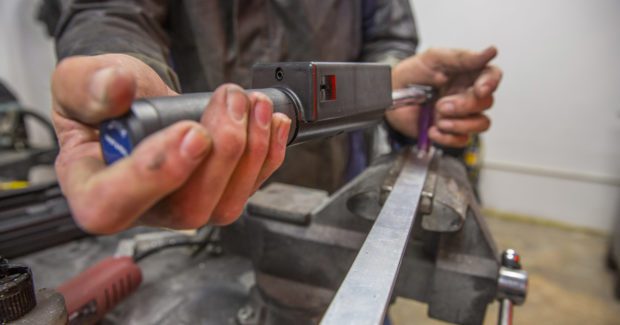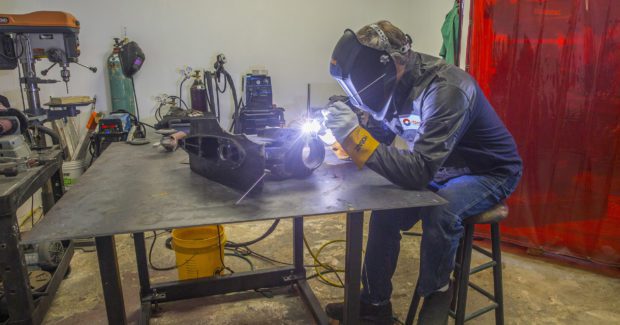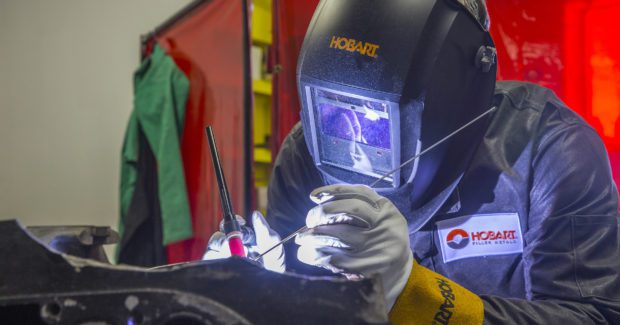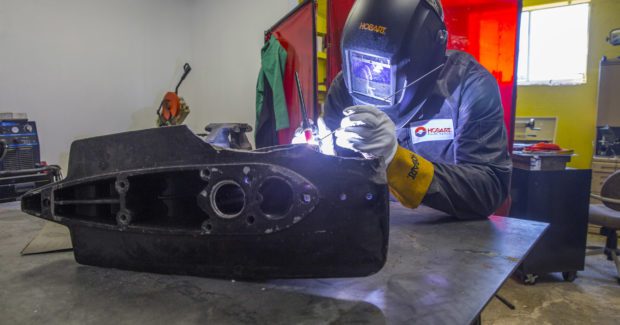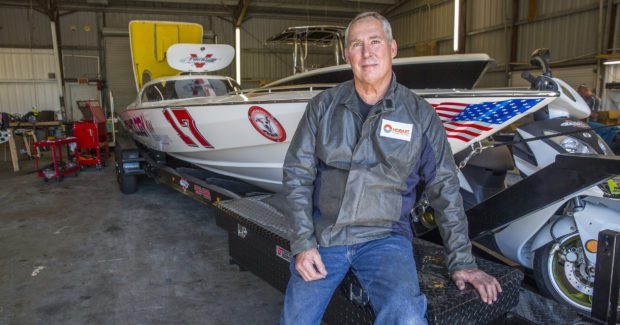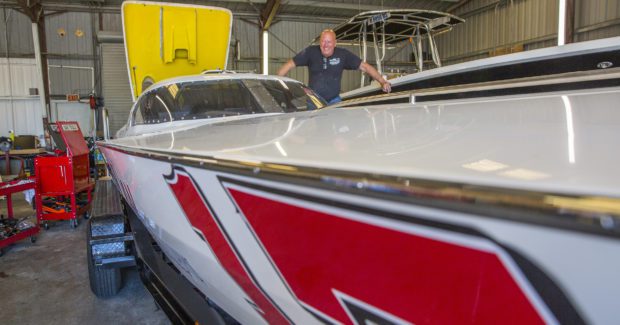How to Get More Weld Strength in Powerboat Propulsion Systems
Nothing pushes the limits of machine performance – or weld strength – like offshore powerboat racing. To meet its demands of higher strength, corrosion resistance, ease of welding and low hot cracking sensitivity, this powerboat drive builder uses an advanced aluminum filler metal that significantly strengthens weld joints after post-weld heat treatment and machining, without affecting the integrity of the base metals.
Posted: October 10, 2016
With speeds sometimes topping 100 mph, offshore powerboat racing is a sport that pushes the limits of machine performance. In the design and fabrication of powerboats, that speed is important to give racers a competitive edge, but reliability and operator safety are even more critical. Warren Berg, the owner of Precision Sterndrive, LLC (Sarasota, FL), understands these unique industry demands. With his 41 years of experience, he builds custom sterndrives: propulsion systems that combine inboard power and outboard drive for offshore racing boats competing at the national level. He specializes in the Bravo and IMCO sterndrives, along with Super Vee light classes and bracket style classes of racing. During 2015, Berg supplied drives for four national racing champions, four world champions, one highpoint winner and one triple crown winner. He also customized drives for an entire class of Super Vee racers.
Berg, a certified Mercruiser MasterTech, uses his decades of expertise in outdrives and motors to hone solutions, specifications and tolerances to meet the needs of his customers. “Over the years, I’ve learned what works and what doesn’t work,” he says. “I’ll set up special specifications and tolerances for the lighter race boats versus the heavier ones. I basically custom-make a drive for each individual boat.” His customers want finished products quickly to prepare for the racing season, but they also expect the highest quality and safety. “When you go into the realm of racing, you’re pushing the limits of the product,” notes Berg. “You don’t want anybody to get hurt, so you have to have the best quality weld.” Given the tight tolerances and specifications required in powerboat fabrication, welds must be as strong and reliable as possible. Heat treatment of the finished weld is a vital part of ensuring those attributes.
To improve the strength and performance of the weld, Berg began using MaxalTig® 4943 aluminum TIG cut-lengths from Hobart Brothers for building custom sterndrives. The TIG cut-lengths offer significantly strengthened weld joints after post-weld heat treatment and machining, without affecting the integrity of the base metals, as compared to the 4043 products he was previously using. Berg has done extensive testing of the welds in both the as-welded and post-weld heat-treated conditions to confirm this fact. “I want to get the job done as fast and as precisely as I possibly can,” he says. “With this new 4943 rod, I can heat-treat my welds so they’re much stronger. Quality is of the utmost importance.”
KEY CHALLENGES
In the marine industry, 6061-T6 and 5356 aluminum materials are commonly used because of their light weight and corrosion-resistance. But because of the thinness of the materials for most powerboat fabrication jobs, cracking near the HAZ can be a common challenge. For Precision Sterndrive, past experiences using 4043 TIG cut-lengths resulted in problems with HAZ cracking in some cases. “There is a lot of vibration on these boats. Sometimes the thinner materials and diamond plate we use inside the boat for aesthetics can crack,” notes Berg.
On boat gear case fabrication and repairs, contaminants in the metals can also be a common issue due to frequent exposure of the components to saltwater. That makes it critical for Precision Sterndrive to keep the material very clean during welding to help avoid problems. “I was constantly grinding and regrinding with a tungsten carbide to keep the material clean,” states. “There can be a lot of junk up on the top. I always had to stop, cut the material and use the stainless brush to clean it off. It’s a tough thing to weld these gear cases that have been used around the saltwater.”
Will Smith, the owner, designer and builder of Phantom Boats LLC (Sarasota, FL), is a longtime Precision Sterndrive customer who encountered an additional problem with welds fabricated and repaired with 4043 aluminum rods: the bearings were actually hammering the aluminum housing and causing the bearings to wear out. “When it comes to offshore racing, we can’t break anything like this. It has to be as strong as it possibly can be,” he says. “It’s an extremely competitive class of racing.”
Berg began looking for solutions to remedy the issues with Smith’s boat, as well as a means to minimize the risk of cracking in the HAZ. He tested the MaxalTig 4943 aluminum TIG cut-lengths and found the filler metal offered benefits for finished weld quality and strength. The 4943 rods are designed as a higher-strength aluminum welding solution that also offers the advantages of using a 4043 aluminum filler metal, including excellent corrosion resistance, ease of welding and low hot cracking sensitivity. The 4943 filler metal also provides the ability to reduce weld size while still improving weld strength. “It is easy to use. I can heat-treat it and come up with fantastic results,” explains Berg. “The finished work was beautiful. There was no porosity and no pitting. I need a weld that is strong, but it also has to be oil-tight or gas-tight. That is the result the 4943 gives me.”
On outdrives that can cost upward of $25,000, it’s critical for Precision Sterndrive to provide their customers with reliable components that will last. Smith was just one of many pleased with the new filler metal. “By using this new welding rod, we were able to build the weld up and then machine it back down,” says Smith. “We have a harder surface for the bearing to push against. It hasn’t worn out since.”
PRETTIER, FASTER WELDING
In addition to the weld strength and quality benefits from a switch to the 4943 product, Precision Sterndrive also found the new filler metal provides aesthetic benefits, as well. This is important for some of the welds the shop completes for customers, such as boat cockpit components. “Everybody likes to see a prettier weld in the engine compartment or in the cockpit,” smiles Berg. “These welds are not only prettier, but they are stronger.” In addition, he can make a single pass much faster with the 4943 rod than he previously could with other filler metals. With a 50/50 mix of helium and argon, Berg finds that one pass is often enough, compared to needing multiple passes with the 4043 TIG cut-length. “I’m using less filler metal because of the change,” he adds. “Plus, it turns a four-hour job into a less than one-hour job for me.”
As word gets out among customers about the success Precision Sterndrive is having with the new 4943 rod, it’s driving more business to the shop. “It has helped bring in new customers and new race teams,” says Berg. “I get a lot of one-off type repairs and fixtures. I need to make repairs and build or fabricate parts within a reasonable amount of time for customers. This rod definitely helps me.” Given the successful results Precision Sterndrive has seen with the 4943 rod, Berg expects the shop will begin using the new filler metal solution for more and more jobs. “I don’t have the problems with parts coming back two months later because they are worn out. If I’m going to put my name on it, the weld has to be strong. It has to be up to certain qualities, which means a general rod just won’t do,” he says. “The more I use 4943, the more I find myself grabbing it. It’s just outstanding in every way.”
Galen White is a senior welding engineer/product specialist at Hobart Brothers Company, 101 Trade Square East, Troy, OH 45373, 800-424-1543, Fax: 800-541-6607, [email protected], www.HobartBrothers.com.





